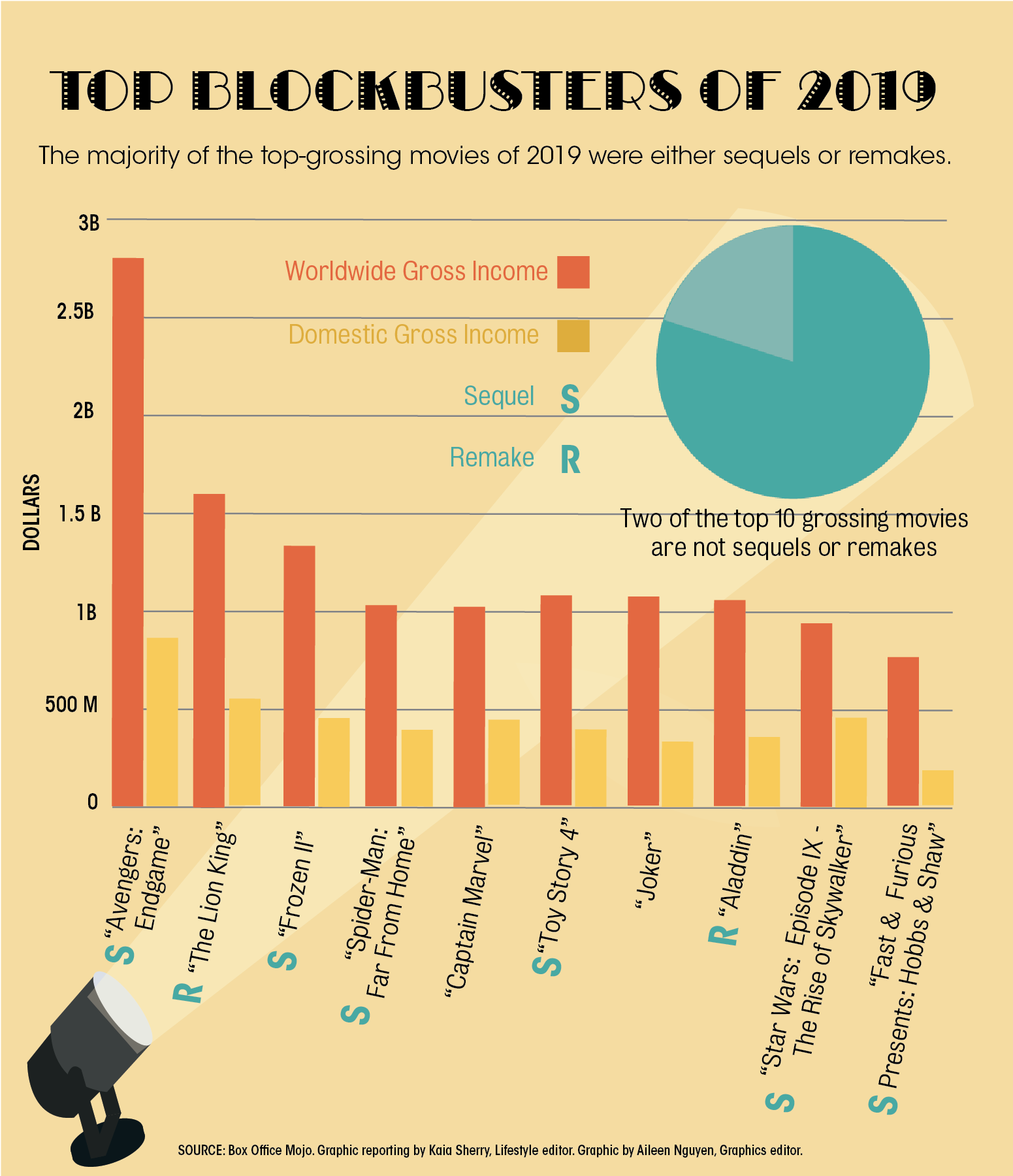Recent Rewinds: Movie sequels and remakes continue stories from one decade to the next

(Aileen Nguyen/ Graphics editor)
By Phillip Leung
Jan. 9, 2020 10:06 p.m.
History repeats itself, and so does art. With films, video games and even books being flooded with sequels, remakes and spinoffs, audiences in recent years have appeared to embrace familiarity over novelty. In Recent Rewinds, columnist Phillip Leung explores the entertainment industry’s inclination toward reimagining and building on old stories.
New year, same movie franchises.
Though 2020 marks the start of a new year, 2019’s trend of movie sequels and remakes will remain. With 2019 ending with the release of the ninth “Star Wars” film – and more spinoffs almost guaranteed to come – as well as the seventh film adaptation of Louisa May Alcott’s “Little Women,” the decade ended with familiar and cherished stories. In the coming months, films such as “Mulan” and “A Quiet Place Part II” are just a couple sequels or remakes to be released in 2020.
[Related: Movie review: There’s nothing small about Greta Gerwig’s adaptation of ‘Little Women’]
While some audiences may tire at the thought of endless retreads of the same story, such reimaginings hold appeal for both studios and audiences by retelling and expanding upon loved stories and characters.
Financially, this trend is hardly a risk. Eight of the top 10 highest-grossing films of 2019 were remakes or sequels of existing franchises, while the remaining two – “Captain Marvel” and “Joker” – were entries of the popular Marvel Cinematic Universe and DC Extended Universe. Clearly, remakes and sequels make sense from a financial standpoint, but box-office figures do not fully explain why moviegoers are so enthused by revisiting familiar worlds.
The success behind sequels is quite easy to explain even beyond finances. When a film constructs a fascinating world with compelling characters, audiences naturally crave more. Superheroes are optimal for such storytelling, providing expansive worlds and a plethora of characters. Each superhero has a unique power lending itself to a distinct story, which can be further amplified by having them interact with other heroes. The MCU certainly proved that. “Avengers: Endgame” is currently the highest-grossing film of all time, a record previously held by “Avatar” for almost 10 years.
While audiences tend to group sequels and remakes together to assert the lack of original stories being told in the film industry, sequels actually do just the opposite. Sequel films usually focus on already-established characters, allowing for even further development.
For instance, “Toy Story 4” explores Woody’s inner conflict between living for himself or Bonnie, his owner. Even though many thought Woody’s story had concluded in “Toy Story 3,” the fourth installment reintroduced Bo Peep, rekindling old relationships while traversing new story grounds. Viewers are already familiar with these characters, so more time could be spent developing new stories and adventures.
Sequels provide an extra layer of storytelling in films, providing multiple options to expand characters and their worlds. They can shed light upon unanswered questions raised in the original, such as in “Frozen II,” which provides a touching backstory to Elsa’s powers and her parents. On the other hand, they can tell separate but interrelated stories, allowing for an even more complex network of characters, as artfully done by the MCU with “Captain America: Civil War.”
Remakes, on the other hand, raise more questions regarding their existence and apparent success. “The Lion King” remake grossed over $1.6 billion internationally. It may seem puzzling why such blatantly unoriginal films are so successful, but film remakes are simply the product of nostalgia and already having a good story to tell. Successful remakes such as “The Lion King” and “Aladdin” were based on critically acclaimed films, so the producers were almost guaranteed a sizable audience with fond memories of the stories.
[Related: Second Take: Despite originality concerns, Disney’s CGI remakes excite long-time fans]
Not all remakes, however, share such success. “Pet Sematary” received mixed critical reception, while “Hellboy” was both negatively received and a box-office bomb. Upon closer inspection, it becomes clear why these remakes pale in comparison to the likes of “The Lion King” – the story wasn’t there to begin with.
The first “Pet Sematary” film adaptation in 1989 also had middling reviews, with a 50% rating on Rotten Tomatoes versus 57% for the 2019 film. Meanwhile, “Hellboy” was originally envisioned as the third installment of the original “Hellboy” films, but evolved into a reboot because of directors and actors stepping down. These production problems yielded a new story that was inferior to its predecessors and focused more on action than substance, according to critics. As seen with these mediocre performances, a recognizable film isn’t an automatic door to success.
Despite being seen as a free pass for a box-office hit, sequels and remakes are subject to as much scrutiny as any other film. However original a story may be, a well-crafted and heartfelt film will always be a good film.


